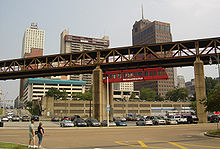
A monorail is a railway in which the track consists of a single rail or a beam. Colloquially, the term "monorail" is often used to describe any form of elevated rail or people mover. More accurately, the term refers to the style of track. Monorail systems are most frequently implemented in large cities, airports, and theme parks.

Wuppertal is a city in North Rhine-Westphalia, Germany, with a population of 355,000. Wuppertal is the seventh-largest city in North Rhine-Westphalia and 17th-largest in Germany. It was founded in 1929 by the merger of Elberfeld, Barmen, Ronsdorf, Cronenberg and Vohwinkel, and was initially "Barmen-Elberfeld" before adopting its present name in 1930. It is the capital and largest city of the Bergisches Land.

A people mover or automated people mover (APM) is a type of small scale automated guideway transit system. The term is generally used only to describe systems serving relatively small areas such as airports, downtown districts or theme parks.
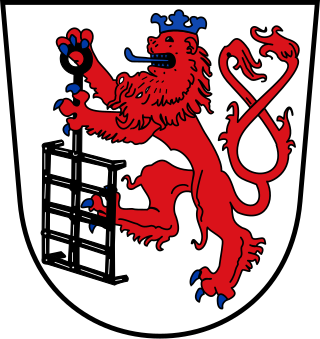
Elberfeld is a municipal subdivision of the German city of Wuppertal; it was an independent town until 1929.

Tuffi was a female Asian elephant that became famous in West Germany during 1950 when she accidentally fell from the Wuppertal Schwebebahn into the River Wupper underneath.
SAFEGE is an acronym for the French consortium Société Anonyme Française d'Etude de Gestion et d'Entreprises and is pronounced in English.

The Dresden Suspension Railway is a suspended funicular located in Dresden, Germany, and connects the districts of Loschwitz and Oberloschwitz. It is one of the oldest suspension railways, having entered service on 6 May 1901, the same year the Wuppertal Schwebebahn entered service. Like the Wuppertal railway, this system was designed by Eugen Langen. The line is 274 metres (899 ft) long and is supported on 33 pillars.
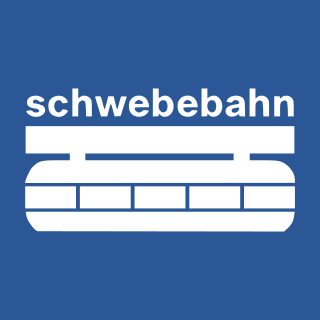
The Wuppertaler Schwebebahn is a suspension railway in Wuppertal, Germany. The line was originally called the German: Einschienige Hängebahn System Eugen Langen named for its inventor, Eugen Langen. It is the oldest electric elevated railway with hanging cars in the world and is a unique system in Germany.

An elevated railway or elevated train is a railway with the tracks above street level on a viaduct or other elevated structure. The railway may be broad-gauge, standard-gauge or narrow-gauge railway, light rail, monorail, or a suspension railway. Elevated railways are normally found in urban areas where there would otherwise be multiple level crossings. Usually, the tracks of elevated railways that run on steel viaducts can be seen from street level.
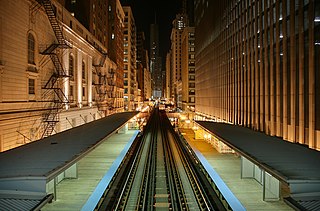
Urban rail transit is a wide term for various types of local rail systems providing passenger service within and around urban or suburban areas. The set of urban rail systems can be roughly subdivided into the following categories, which sometimes overlap because some systems or lines have aspects of multiple types.

The Shonan Monorail is a suspended SAFEGE monorail in the cities of Kamakura and Fujisawa in Kanagawa Prefecture, Japan. It is operated by the Shonan Monorail Co., Ltd. which belongs to Michinori Holdings, and opened on March 7, 1970, the first monorail of its kind in Japan.

The H-Bahn in Dortmund and Düsseldorf is a driverless passenger suspension railway system. The system was developed by Siemens, who call the project SIPEM.
The term monorail or industrial monorail is used to describe any number of transport systems in which a chair or carrier is suspended from, or rides on, an overhead rail structure. Unlike the well-known duo-rail system, there are many rail-guided transport options which have been described as monorails, so that tracing the history presents a demarcation problem regarding what should be included and what should be omitted.
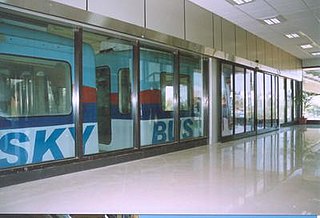
The Skybus Metro was a prototype suspended railway system by Indian technologist B. Rajaram with the BEML and Konkan Railway which is patented by the Indian Railways. The system consisted of an elevated track with the cars suspended below, similar to the Wuppertal Schwebebahn or H-Bahn systems in Germany.
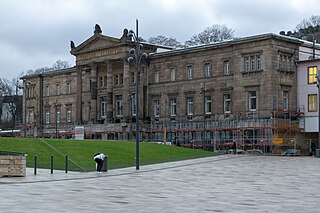
Wuppertal Hauptbahnhof is a railway station in the city of Wuppertal, just south of the Ruhr Area, in the German state of North Rhine-Westphalia. It is on the line between Düsseldorf/Cologne and Dortmund. The 1848 reception building is one of the oldest of its kind. The station was originally Elberfeld station and has been renamed several times since. Since 1992, it has been called Wuppertal Hauptbahnhof. Wuppertal Hauptbahnhof is also the site of lost luggage operations for Deutsche Bahn.

Henry Robinson Palmer (1795–1844) was a British civil engineer who designed the world's second monorail and the first elevated railway. He is also credited as the inventor of corrugated metal roofing, still one of the world's major building materials.

Vohwinkel station is the most western station in the city of Wuppertal. It is located in the district of Vohwinkel. It is a triangular station, built at a railway junction.
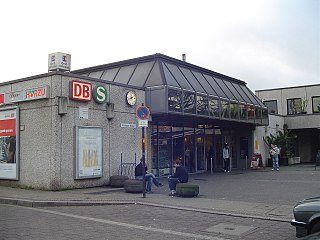
Wuppertal-Oberbarmen station is located in the city of Wuppertal in the German state of North Rhine-Westphalia. Historically, it served as a significant railway junction, connecting to four railway lines. Presently, the station is served by two remaining lines: the Dortmund–Wuppertal main line and the branch line to Solingen.

The Wuppertal Schwebebahn accident took place on 12 April 1999 on a stretch of track near Robert-Daum-Platz station. The accident, involving car number 4 from the WSW GTW 72 series, killed five people and injured 47, some of them seriously. It remains the worst accident in the railway's history and the only one since the railway opened in 1901 to have had a deadly outcome.

The GTW 72 is a suspended monorail train type operated by Wuppertaler Stadtwerke on the Wuppertal Schwebebahn from 1972 until 2018.
